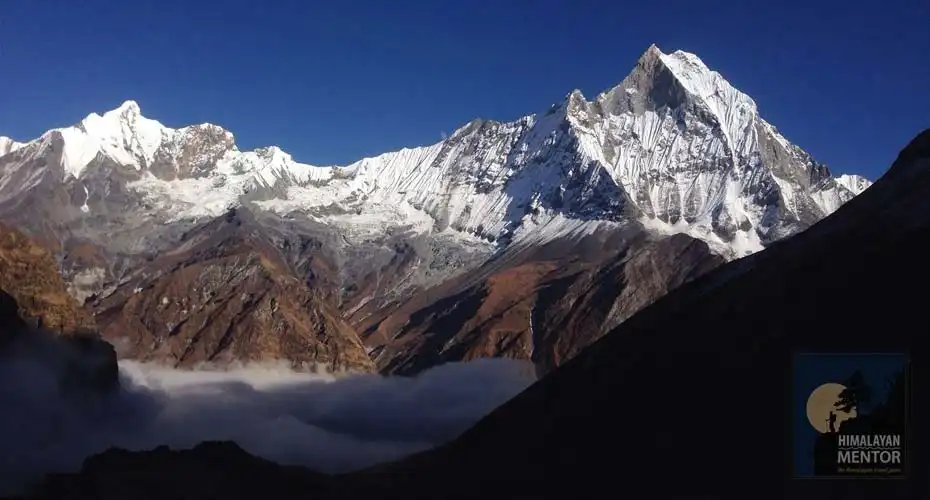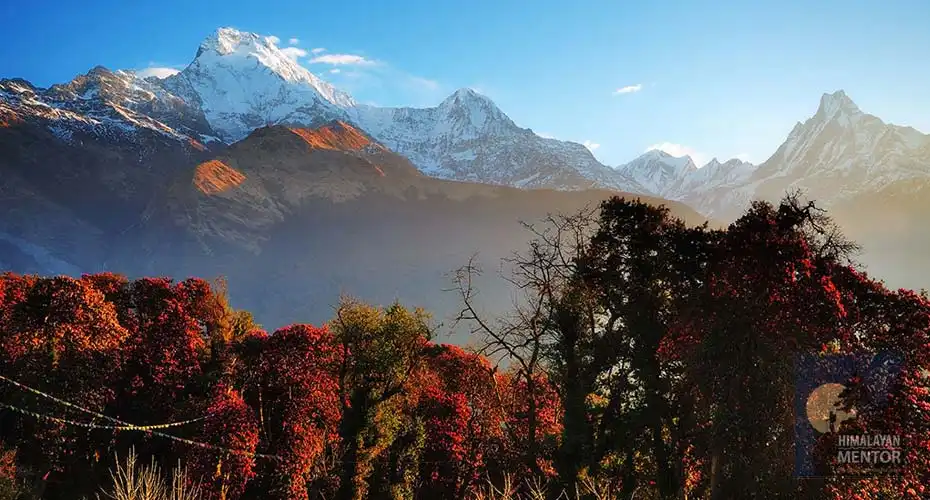Annapurna base camp trekking guide
Embarking on the adventure of an Annapurna Base Camp trek requires thorough preparation to enhance your chances of success and ensure a safer and more enjoyable experience. As seasoned guides leading multiple Annapurna Base Camp treks annually, we present our exclusive top 10 tips to optimize your journey.

1. Pre-Trek Conditioning is Key
Prioritize physical readiness before setting foot on the trail. Despite spending minimal time at high altitudes, the Annapurna trek is demanding, featuring thousands of stairs and varied terrains. Familiarize yourself with the challenges, and if you join a trek with Himalayan Mentor, we'll guide you on understanding the terrain and requisite training.
Conquer Ascents and Descents
The trek involves traversing mountain passes, going downhill, and then ascending again. Adequate preparation is essential, including training for downhill sections. The Annapurna Base Camp Trek showcases the renowned trail to Poon Hill and the Annapurna Sanctuary, requiring physical fitness but not demanding technical climbing or altitude experience.
Attain Mountain Fitness
While technical climbing expertise isn't necessary, robust physical fitness, strength, and endurance are imperative for a fulfilling trek. Train your body to endure constant strain at altitude by engaging in intense physical exercises at least four to five days a week for about six months before your trek begins.
Establish a Regular Training Routine
Devote at least four days a week to uphill walking on a stair-master, gradually increasing the duration to one to one hour 30 minutes while carrying a 10-kilo (22lbs) backpack. Additionally, incorporate one day a week for outdoor hikes in hills or mountains. Aim for a weekly hike of 3 to 6 hours, gradually building up to 800m/2,600 feet elevation gain and descent.
Imitate Trek Conditions in Training
Replicate trek conditions during your training to build muscle strength and memory. Mimic the distances and terrains you'll encounter on the Annapurna trek. This specific training approach is crucial for preparing your body for the challenges of walking long distances day after day for 12 consecutive days.
Train Smart for Downhill Sections
If mountains or hills aren't accessible for training, simulate the experience by adding extra weight to your backpack and incorporating longer walks on the treadmill or in the gym. This strategy ensures that your muscles are well-prepared for the downhill stretches of the Annapurna Base Camp Trek.
2. Mental Mentally Prepare for the trek
Adjusting your mindset is essential, particularly if you're not entirely at ease with outdoor living. Ideally, those opting for a journey like this are enthusiasts of the outdoors and are well-acquainted with mountain living. The mountain environment may bring about encounters with bugs, dirt, improvised showers using baby wipes, and the necessity of outdoor bathroom breaks. For those unaccustomed to rugged conditions, mental preparation becomes paramount.
Embrace the Wilderness
Lifestyle During our Annapurna Base Camp Trek, all accommodations consist of quaint tea houses managed by local residents. While the sleeping arrangements may not offer the epitome of comfort, you'll have a bed in a twin-shared room. Showers are available at select trail stops, but many choose to stay fresh using daily rituals involving baby wipes and a basin of warm water.

Toilet Challenges
Navigating the toilet facilities can be challenging, with some tea houses featuring non-Western style toilets—essentially just a hole in the ground. Additionally, be prepared to embrace nature's call when there's no tea house nearby on the trail. Anticipating and mentally readying yourself for these aspects is crucial to avoid arriving on the mountain with unrealistic expectations and potential disappointment.
By adhering to these tailored tips, you'll elevate your readiness, enhance your trekking experience, and increase the likelihood of successfully conquering the Annapurna Base Camp.
3. Equip Yourself Appropriately
Selecting the right gear is pivotal for a successful Annapurna Base Camp Trek. While a comprehensive gear list is beyond the scope here, we'll highlight key essentials that demand attention.
Prioritize Footwear
Your feet bear the brunt of the trek, making proper footwear indispensable. Never compromise on quality when it comes to shoes, especially when facing several hours of daily walking over a ten-day period. Invest in robust, waterproof trekking boots, ensuring you break them in before your journey to Nepal.
Invest in a Quality Down Jacket
A crucial item for the trek is a high-quality down jacket with ample baffling and down insulation. The fill power indicates the quality of the down, with higher numbers denoting superior quality. For instance, 800 fill refers to the down's quality, not necessarily its warmth—choose a jacket that aligns with the anticipated conditions. You may find more about the equipment for ABC trek here.
4. Prioritize Hydration
When venturing to higher altitudes, maintaining proper hydration stands out as a paramount tip. At elevated levels, your body tends to dehydrate more rapidly than it would at sea level.
To counteract this, ensuring a consistent intake of fluids is crucial. We recommend consuming four to five liters of water daily while in the mountains. Different types of water bottles become invaluable in facilitating this.
Strategize Your Water Consumption
The strategy for optimal hydration involves drinking one liter of water in the morning before commencing your trek. Subsequently, fill your bladder with two liters for the morning journey. Refill the bladder with an additional two liters during lunch.
By adhering to this routine daily in the mountainous terrain, you can maintain proper hydration, ward off headaches, and support your overall success. While the prospect of consuming five liters of water daily may seem daunting, it plays a pivotal role in your well-being amidst the mountain challenges.
5. Embrace the Challenge of Altitude Headaches
Ascending to higher altitudes poses challenges, and it's almost inevitable that you may encounter headaches during the journey. Effectively managing these headaches without allowing them to escalate or dampen your experience is crucial.
Stay Hydrated
A potent strategy for combating altitude-induced headaches is adhering to the advice from Tip 4—maintain consistent hydration in the mountains. Dehydration is a common trigger for headaches at altitude, so ensuring adequate water intake can significantly reduce or alleviate these discomforts.
Arm Yourself with Ibuprofen
In the face of altitude-induced headaches, having ibuprofen on hand is a practical solution. Ibuprofen, known for its anti-inflammatory properties, effectively addresses swelling and pressure—the primary contributors to altitude headaches.
Experiencing headaches at high altitudes is a normal part of the journey and should not instill excessive fear. However, if your headaches intensify and are accompanied by other symptoms of altitude sickness, descending to lower altitudes may be necessary for relief.
6. Walk slowly and on steady pace
Embarking on challenges like the Annapurna Base Camp Trek, or any extensive trek or climb, demands a mindset that acknowledges it as a marathon, not a sprint. Acclimatizing to the diminished oxygen levels in the mountains necessitates a deliberate approach, allowing your body to gradually adjust to the oxygen scarcity.

Research consistently underscores the significance of spending more time at altitudes around 3,500m/11,500 feet before ascending further. This step is pivotal for your triumph in the mountainous terrain.
Ensure that your chosen itinerary emphasizes extended periods for acclimatization rather than cutting them short. If a safe and successful ascent to higher altitudes is your goal, dedicating ample time to acclimatize becomes indispensable. Avoid opting for expeditions that attempt to hasten your journey up the trail swiftly, as rushing is the primary factor contributing to unsuccessful ventures.
7. Protect Yourself From the High-Altitude Sun
As you ascend in altitude, the UV protection diminishes, exposing you to the intense rays of the sun during certain segments of the trek. On the trail, the sun can be relentless, emitting potent solar radiation.
Shielding yourself from the sun extends beyond preventing wrinkles and minimizing the risk of skin cancer—it directly impacts your trek's success by averting dehydration associated with sunburn.
Given that dehydration is a major hurdle to success at altitude, proactive measures against harsh sun exposure are crucial. While daytime walking may offer little refuge from the powerful rays, it's imperative to take diligent steps to mitigate their impact.
Wearing sunblock with at least SPF 30/50 and reapplying it throughout the day is non-negotiable. The mountains aren't the ideal location for cultivating a holiday tan. Equally important is donning a sun hat and opting for long pants and sleeves to enhance sun protection.
Invest in a lightweight, brimmed sun hat, particularly on sunny days, and safeguard yourself against the sun's intensity. This thoughtful approach can spare you from the dreaded headaches you're keen to sidestep during your journey.
8. Prioritize Acclimatization
Undertaking an extended trek, such as the Annapurna Base Camp journey, requires a mindset attuned to a marathon rather than a sprint. Acclimating to the reduced oxygen levels in the mountains demands a gradual, thoughtful approach.
Slowly acclimating your body to the oxygen scarcity becomes imperative, and extensive research on high altitudes underscores the importance of spending more time at the critical acclimatization juncture of 3,500m/11,500 feet.

Our Annapurna Trips uniquely incorporate a hike to the renowned Poon Hill, reaching an elevation of 3,200m/10,531 feet—a feature that sets us apart from other expeditions. Opt for an itinerary that allows for extended acclimatization periods, and consider trails that include Poon Hill for added acclimation benefits. To ensure a safe and successful altitude venture, dedicating ample time to acclimatization is non-negotiable. Beware of expeditions that attempt to hurriedly propel you up the trail, as this rush is the primary factor contributing to unsuccessful outcomes.
9. Embrace the Holiday Spirit: Enjoy Your Journey!
The pivotal reminder here is that you are on vacation—relax, adopt an open mindset, and savor the experience! A trek like Annapurna Base Camp allows for ample downtime, with daily walks ranging from 4-6 hours, occasionally extending on a few days.
Upon reaching the tea houses, you have generous time to unwind, rejuvenate, and share laughter with your fellow trekkers. This downtime is essential throughout your journey, fostering a positive and relaxed atmosphere instead of tension and nervousness.
Additionally, recognize that you're immersing yourself in a distinct environment compared to your familiar home setting. Practices in Nepal may differ from what you're accustomed to, not implying a wrong approach but rather a unique one. Maintain an open mind, acknowledging cultural variations along the way, and show respect for those assisting in achieving our shared goals.
10. Consult with Seasoned Trip Planners for a Seamless Trek!
Ensure a smooth and secure trekking experience by booking through a government-registered trekking agency and partnering with a certified guide. When planning, it's crucial to engage with experts who comprehend your needs and can craft the optimal itinerary within your available holiday timeframe.
These ten tips serve as valuable insights for an Annapurna Base Camp Trek. We trust that they will aid you in meticulous planning for this extraordinary trek of a lifetime. Should you express interest in our Annapurna Base Camp Trek, feel free to reach out, and we will guide you through the entire process.
